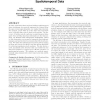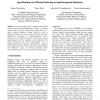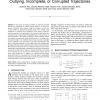348 search results - page 44 / 70 » Indexing the Trajectories of Moving Objects |
SSD
2001
Springer
14 years 1 months ago
2001
Springer
In dynamic spatio-temporal environments where objects may continuously move in space, maintaining consistent information about the location of objects and processing motion-speciļ¬...
ISAAC
2007
Springer
14 years 2 months ago
2007
Springer
Widespread availability of location aware devices (such as GPS receivers) promotes capture of detailed movement trajectories of people, animals, vehicles and other moving objects, ...
KDD
2004
ACM
14 years 9 months ago
2004
ACM
In many applications that track and analyze spatiotemporal data, movements obey periodic patterns; the objects follow the same routes (approximately) over regular time intervals. ...
SSDBM
1998
IEEE
14 years 28 days ago
1998
IEEE
: A new issue that arises in modern applications involves the efficient manipulation of (static or moving) spatial objects, and the relationships among them. As a result, modern da...
PAMI
2010
13 years 7 months ago
2010
āIn this paper, we study the problem of segmenting tracked feature point trajectories of multiple moving objects in an image sequence. Using the afļ¬ne camera model, this proble...



